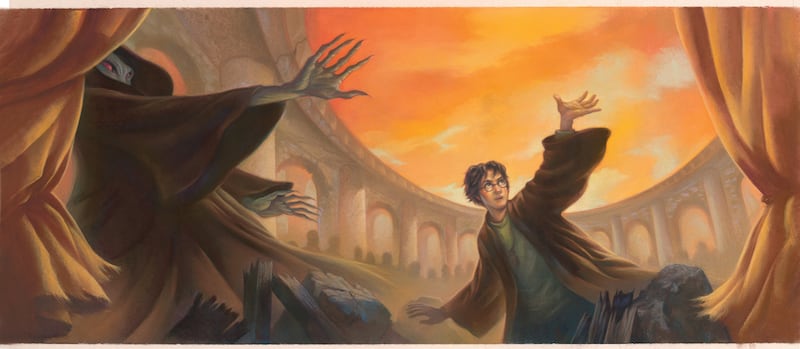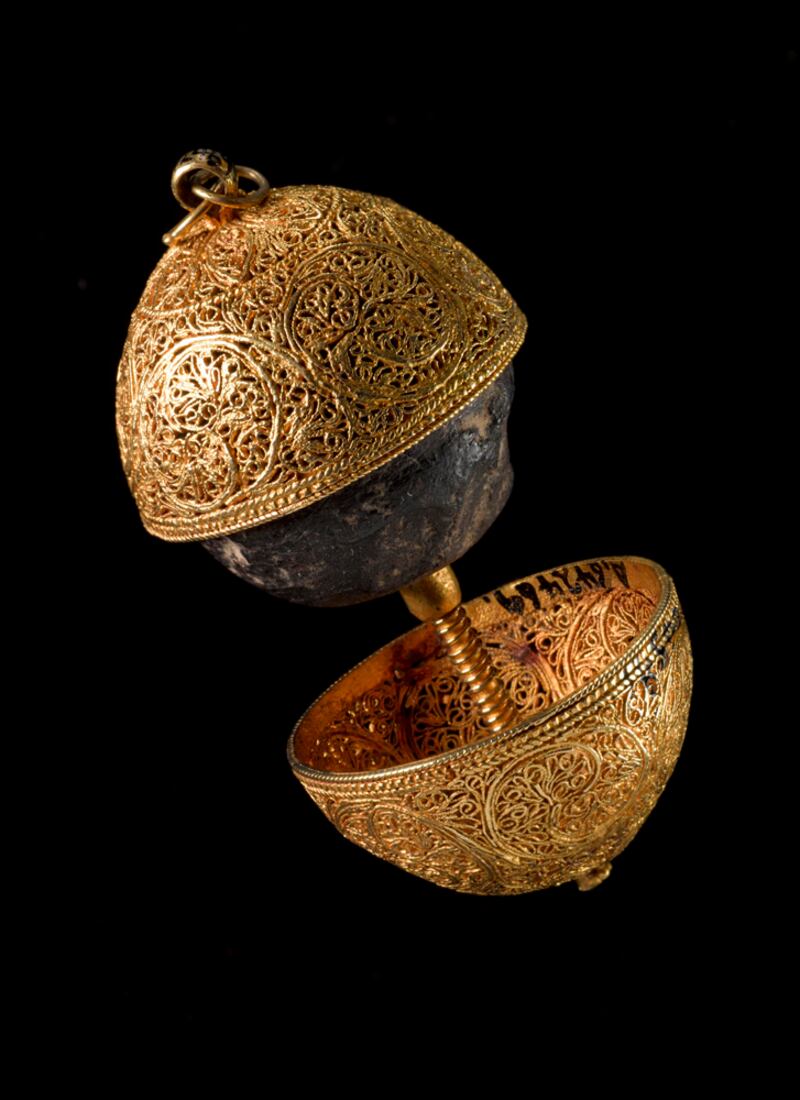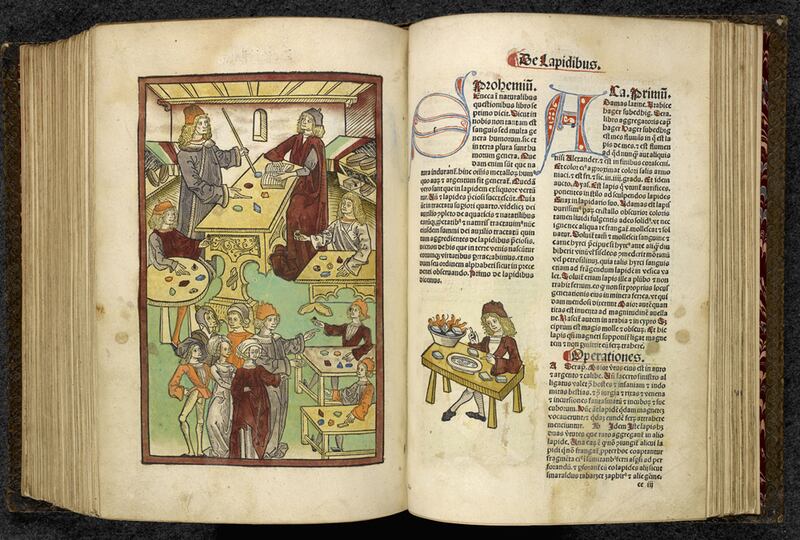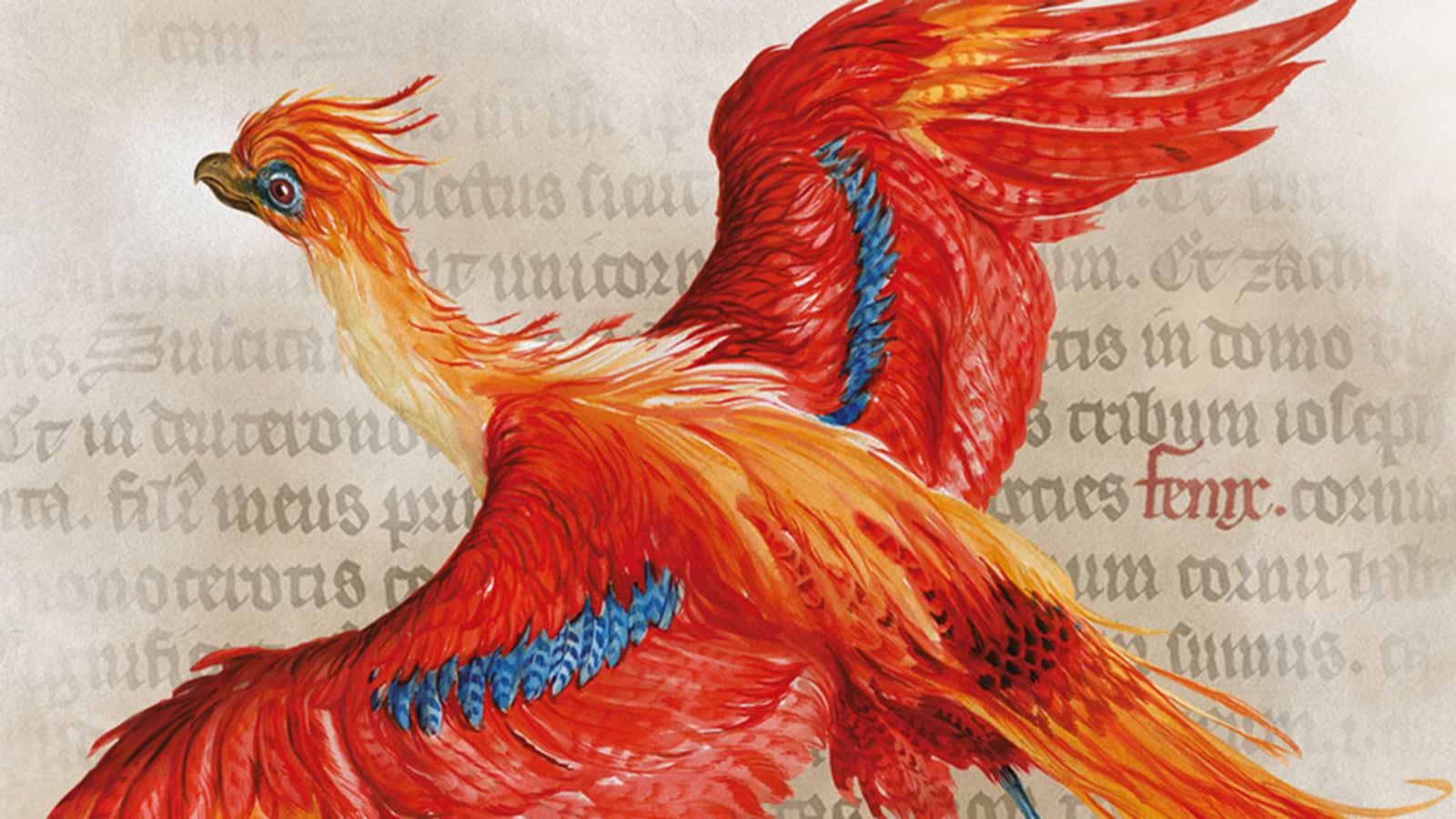I’m a self-professed Harry Potter nerd. Currently, I’m in the middle of my annual reread of the books, and these past couple weeks, American news has reminded me of the darkest parts of the stories.
I was badly in need of a reminder of why I love the books, aside from their acute relevancy. The New York Historical Society’s Harry Potter: A History of Magic exhibit did not let me down.

Mary GrandPré considered ‘Harry Potter and the Deathly Hallows’ her most favorite cover. It depicts a fiery orange sky, cracked and battered walls of Hogwarts, and eerie shadows that create a backdrop for the ultimate confrontation between the Boy Who Lived and the Dark Lord. Near the center of the cover, the resurrected Harry is captured in the moment he defeats Voldemort once and for all.
Warner Bros. Corporate Archive via New-York Historical SocietyThe show commemorates the 20-year anniversary of Scholastic’s publication of J.K. Rowling’s Harry Potter and the Sorcerer’s Stone in the United States. an expansion of the British Library’s most successful exhibition.
Right outside of the exhibit entrance, you get a look at the oversized steamer trunk that was used to carry a signed copy of Harry Potter and the Half-Blood Prince on the ship Queen Mary 2 to the States.
In a glass case are original illustrations from Scholastic’s American cover artist Mary GrandPré, new art for the 20th anniversary editions from Brian Selznick, 15th anniversary art from Kazu Kibuishi, and art from Jim Kay. Americans may best recognize GrandPré’s pastel strokes, but it is a treat to experience the way different artists have visually translated the characters.
Two large stone owls lent by the Brooklyn Museum flank the exhibit's entrance.
Inside is an impressive collection of rare artifacts, books and magical objects that provide context to J.K. Rowling’s stories. The show is cleverly sectioned into displays themed around core Hogwarts School of Witchcraft and Wizardry subjects: Potions, Herbology, Divination, Charms and Astronomy, Defense Against the Dark Arts, and the Care of Magical Creatures.
Each room twists into the next, shadowy walls lined with portraits of Hogwarts professors and school books. In one room, a golden snitch is projected darting high on the wall. Symbols popularly associated with the series, like tea cups, pointed hats and brooms, are suspended in mid-air mobiles from the ceiling.

Bezoars were first introduced into medieval Europe by Arab physicians. Wealthy owners spent considerable sums on acquiring them, and often kept their stones in elaborate cases. A corruption of the Persian word pādzahar (pād, expelling; zahar, poison), bezoars reputedly provided a powerful antidote to poison.
Courtesy Wellcome Collection via New-York Historical SocietyThe rooms are thoughtfully curated. In the "Potions" section, you can glimpse an actual bezoar stone, which is a key antidote in Harry Potter and the Half-Blood Prince (“Just shove a bezoar down their throats!” young Severus Snape famously scribbled in his Potions textbook).
In the "Herbology" room, there is an 18th-century mandrake root from the New York Botanical Garden Library, as well as a 15th-century manuscript that depicts the harvesting of a mandrake.
"Divination" showcases oracle bone fragments from the Metropolitan Museum of Art and an interactive tarot card game. "Charms" features the first written record of the “abracadabra” enchantment from the 13th century. "Care of Magical Creatures" leans heavily into owl imagery, with a wall of John James Audubon’s watercolors of owls—a sly set-up for the stuffed owls and owl mugs in the gift shop.

Hortus Sanitatis (Latin for ‘The Garden of Health’) is the first printed encyclopedia of natural history, featuring sections devoted to plants, animals, birds, fish, and stones. This hand-colored woodcut illustration shows a Potions class.
Courtesy British Library Board via New-York Historical SocietyAs enjoyable as the artifacts are, the real reason to pay for this exhibit is to glimpse the J.K. Rowling’s raw work, from unpublished scenes to handwritten planning notes to her illustrations.
I had no idea Rowling was such a gifted illustrator before this exhibit. (Note to the publishing gods: I’d happily pay for a bookful of her drawings!) It is thrilling to be an inch away from a sketch Rowling penned herself of Hagrid, Professor Dumbledore, and Professor McGonagall cradling baby Harry on Privet Drive.
I spent most of my time at the exhibit poring over Rowling’s scribbles. It is there that you discover all the hidden words that could’ve been. For instance, did you know that Dean Thomas was once slated to be named Gary? Or that the Divination teacher may have been called Enid Pettigrew instead of Sybill Trelawney? In a cut scene from the book, you find that Rowling once toyed with having Cornelius Fudge deliver young Harry to the Dursleys.
Perhaps my favorite piece in the show was a giant, scrawled, chapter-by-chapter plan Rowling laid out for Half-Blood Prince. Here you see all the chapter names and plot developments that made final print—and those that did not.
Almost all of Rowling’s sketches and plans were made around 1990, years before the books were actually published. For me, and I suspect for any major fan of this universe, the true draw for this exhibit is the startlingly intimate glimpse into the author’s brain that it provides. Through scraps of paper, you glimpse how intentional, how meticulously thought out, her decisions were.
A History of Magic provides fascinating, physical, Muggle-based context to Rowling’s stories, but it is the creator’s own context that proves most magical.
Come for the history, but stay for the Rowling.
New-York Historical Society’s Harry Potter: A History of Magic runs until Jan. 27, 2019.







